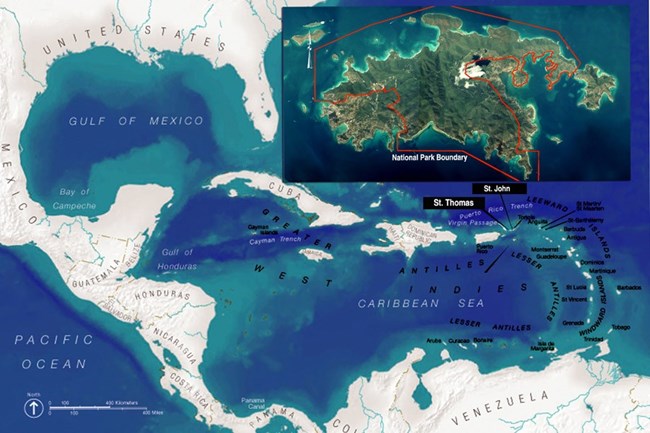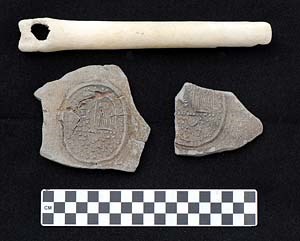Last updated: March 18, 2024
Article
Making Contact with the Archeological Record: Identifying Contact Period Sites on St. John, U.S. Virgin Islands

Little is known about the actual interactions between indigenous populations, Europeans, and Africans during the early period of European expansion, despite its importance to global history. The U.S. Virgin Island of St. John is no exception -- but archeology within Virgin Islands National Park illuminates this less-known aspect of the island's story.
St. John is a 20-square-mile island colonized in 1718 by Denmark. The Danish government sent out settlers, in defiance of both British and Spanish imperial claims to the island, as early as 1672. The settlers found “only a few Indians" there. No indigenous people lived on St. John by the 18th century. Who were the indigenous inhabitants that were encountered at the time of European contact, and what became of them? How did the Danish colonists adapt to new social, economic, and environmental conditions?
Archeologists at Virgin Island National Park undertook research to identify sites dating to European contact and colonization. Information from these sites demonstrates social relationships between Taino and Island-Carib Indians, Europeans, and Africans during the 17th and 18th centuries.
Taino and Island Carib Indians
Archeological research confirmed Taino occupation throughout the Virgin Islands. Early historic records show Island-Caribs in the Virgin Islands when Columbus arrived. Other members of Columbus's expedition called the native people of St. Criox “camballi” or “canabales” -- terms originating from the ship’s Taino translator’s word for man eaters or cannibals. Soon, the Spanish “canabales” became “caribal” and then "Carib." Whether the term was true or not, it became a rationale for conquistadors to exterminate and enslave indigenous people.
The Spanish displaced and destroyed Native Americans first through violence and then by disease. Taino from Puerto Rico and the Island-Carib banded together in 1509 to assault the Spanish in Puerto Rico. Consequently, in 1511, the crown issued a Real Cedula that Caribs everywhere could be exterminated. Almost immediately, St. Croix, to the south of St. John, was depopulated. Survivors escaped and carried on a fight against the Spanish from the northern Virgin Islands. In 1514, the Native Americans were badly defeated. By 1518 European diseases destroyed their ability to resist Spanish domination. After 1519, the Virgin Islands may have remained depopulated for a short period.
Archeologists identified several sites probably associated with Native Americans who the Spanish displaced in 1509 to 1519 on the island’s south shore. The area was hidden from ships on the more commonly-used routes between the islands. Native Americans did not occupy the sites for very long.

Archeological Research at Cinnamon Bay
Archeological excavations at Cinnamon Bay revealed undisturbed deposits dating to prehistoric and proto-historic times. An early 1600s sand road built over the site had reduced subsequent subsurface disturbance. Radiocarbon dates from the twelve 10 cm levels define a temporal timeline from AD 1060 to AD 1810. This evidence correlates with the Pre-Columbian ceramic and historic material culture stylistic shifts observed in the cultural deposits. The dates, along with the ceramic styles in the last levels, indicate that the Taino culture developed rapidly. The deposits in the upper 30 cm date to when cultures collided. Level 3, 20-30 cm below the surface, was dated to AD 1270 to 1400. The second level, 10 to 20 cm below surface, was dated to AD 1390 to 1440. In these levels classic Taino effigies and offerings were prevalent.
Level 1, from surface to 10cm below, contained pre-Columbian pottery, but specific Taino designs, effigies, and offerings are absent. Radiocarbon dates from the uppermost level indicated that the site was re-occupied from AD 1650 to AD 1810. This suggests that the Taino culture on St. John disappeared prior to Columbus’s arrival in the New World.
European Colonization of the Virgin Islands
The close proximity of St. Thomas and St. John to the heart of the Spanish realm soon created a hub of activity. Rival European powers attempted to establish footholds around the area. By the 1500s the English, followed quickly by the Dutch and French, attempted to use the island’s strategic location. Buccaneers and pirates quickly saw the advantages offered by the unpopulated island and protected harbors, and often sought refuge on St. John and St. Thomas Islands. Within the park’s boundaries, archeological sites provided clues to this transitional period and cultural clash in Virgin Island’s history.
As the 16th century passed into the 17th, the French, English and Dutch repeatedly claimed the islands, only for the Spanish, each other and disease to destroy their settlements. Constant turmoil and cultural collision caused the first Danish settlement on St. Thomas to fail in 1665. In 1672, the Danish tried again; this time, they survived. Their relative neutrality in European affairs provided a buffer zone between warring European nations. The Danish opened their port to all nationalities.
It was, however, difficult to convince Danish citizens to make the dangerous journey across the Atlantic. Those who did were mainly indentured servants. Although St. John was officially controlled by the Danish West India and New Guinea Company, many different nationalities were represented on the island as land and slave holders, including French Huguenots; German European Jews; and Africans, both free and enslaved. Many of those had good reason not to record their affairs, were not allowed to, or did not have the means.
Like other European nations, the Danes sought their own power and wealth through the trans-Atlantic slave trade, establishing a trading post on Africa’s Gold Coast at Accra. After official colonization of St. John it took only 15 years for the Danish West India and New Guinea Company to establish 109 sugar, cotton and provisioning plantations with the labor of over 1,000 enslaved Africans; and a primarily absentee European planter population.
African Revolt in 1733
In 1733, a small group of African laborers, historically identified as “Alminas” (after the plantation where the revolt started), revolted against the European Creole society. They instigated the first successful slave revolt in the New World. When the island erupted into violence, it was briefly ruled by enslaved Africans. French troops came to the aid of the mercantilist Danes, hoping that military intervention in the Caribbean would mean Franco-Danish cooperation in Europe. Before the 1733 revolt, the French exercised considerable freedoms in the Danish West Indies. Prior to formal colonization of St. John, the French governors on St. Croix complained extensively to the Danish officials of French deserters finding refuge on Danish soil.
At this time, Africa was also undergoing turbulent cultural change brought into motion by contact with European slave traders. Slaving activities brought significant population movements and corresponding shifts in West African power structures. Peculiar relationships resulted between African and European groups, who had previously been slave trading partners in West Africa, but were now involved in relationships of enslavement on St. John. The amount of heterogeneity visible in the historic record allows a more sophisticated and nuanced approach to the archeological record of the slave revolt. The ability to get beyond identifying cultures monolithically as “European” or “African” raised questions about the status of enslaved Africans as both colonized and colonizer.
Archeological Research at Turtle Point
Archeologists investigated an earth disturbance along the shoreline at the Caneel Bay Resort at Turtle Point. Turtle Point is a multi-component site incorporating both prehistoric and historic events. Excavation revealed a mix of historic and prehistoric ceramics and lithics including stone belts, Chinese porcelains, ground stone implements, and shell buttons.
One of the most intriguing finds was a French honey-colored gun flint that showed heavy use-wear. Caneel Bay saw the largest battle between Africans and Europeans involved in the 1733 uprising. Historic documents claimed that the island’s planters made their last heroic stand against the mutinous slaves at Turtle Point before being driven into the sea and onto the cays that surround St. John. Was this single gunflint discarded or lost by French deserters? Was it lost by troops during the battle that raged on this point between African rebels and European and African militia reclaiming their land? Or was it simply evidence of the extensive trade between the European powers in the Caribbean during this era?
This single artifact is only the tip of the archeological iceberg. The task of Virgin Island NP's archeologists is to continue chipping away at questions surrounding the interactions of peoples living on the island and understand the legacy of the culture that was born from contact between Native Americans, Europeans, and free and enslaved Africans.
References
Allaire, Louis
1997 The Caribs of the Lesser Antilles. In Samuel M. Wilson (ed). The Indigenous People of the Caribbean. The Ripley P. Bullen Series. University Press of Florida, Gainesville.
Armstrong, D.
2003a Creole Transformation: From Slavery to Freedom. University of Florida Press, Gainesville.
2003b The Shoreline Settlement at Cinnamon Bay, St. John, USVI: A Small Estate Established Before Formal Colonization and Burned During the Slave Rebellion of 1733. Paper presented at the Society for Historical Archeology.
Armstrong, D., M. Hauser, and D. Knight
2005 Historical Archeology of Cinnamon Bay Shoreline Estate: Explorations of a Small Cotton Estate and its Transformation in an Emerging Danish Sugar Economy, St. John, United States Virgin Islands (National Park Site Designation: VIIS 191) Syracuse University Archeology Research Center.
Caron, A. and A. Highfield
1981 The French Intervention in the St. John Slave Revolt of 1733-34. The Bureau of Libraries, Museums and Archeological Services, Department of Conservation and Cultural Affairs.
DeCorse, C.
1993 The Danes on the Gold Coast: Culture Change and the European Presence. The African Archeological Review 11:149-173.
DeCorse, C.
2001 An Archeology of Elmina. Smithsonian Institution Press, Washington D.C.
Dookhan, I.
1994 A History of the Virgin Islands of the United States. Canoe Press, Kingston.
Figueredo, Alfredo E.
1978 The Virgin Islands as an Historical Frontier between the Tainos and the Caribs. In Revista/Review Interamericana. Vol. VIII, No. 3 (Fall) 393-399.
Fog Olwig, K.
1985 Cultural Adaptation and Resistance on St. John: Three Centuries of Afro-Caribbean Life. University of Florida Press, Gainesville.
Hatt, Gudmund
1924 Archeology of the Virgin Islands. Proceedings of the XXIth International Congress of Americanists (1), 29-42. The Hague.
1932 Notes on the Archeology of Santo Domingo. Geografisk Tidskrift 35. Copenhagan.
1941 Had West Indian Rock Carvings a Religious Significance? Nationalmuseets Skrifter, Etnografisk Raekke 1. Copenhagan.
Herneas, P.
1995 Danish Slave Trade from West Africa and Afro-Danish Relations on the Eighteenth Century Gold Coast. University of Trondheim Press, Trondheim.
Larsen, L. C.
1986 The Danish Colonization of St. John 1718-1733
Virgin Islands Resource Management Cooperative.
Miller, Lee
2000 Roanoke: Solving the Mystery of the Lost Colony. Arcade Publishing New York.
Morse, B. Faber
2004 At the onset of complexity: Late Ceramic developments in St. Croix. In Andre Deluech and Corinne L. Hofman (eds). Late Ceramic Age Societies in the Eastern Caribbean.183-193 Paris Monographs in American Archeology 14 (Publication of BAR International Series 1273).
Pannet, P.
1733 [1994] The Conspiracy of the Amina Negroes on St. John. In The Kamina Folk: Slavery and Slave Life in the Danish West Indies, edited by G. Tyson and A. Highfield. Virgin Islands Humanity Council.
Righter, Elizabeth, Ken S. Wild and Emily R. Lundberg
2004 Late Ceramic Age Development in the Virgin Archipelago: The Puerto Rican Connection. In Andre Deluech and Corinne L. Hofman (eds). Late Ceramic Age Societies in the Eastern Caribbean. 101-118 Paris Monographs in American Archeology 14 (Publication of BAR International Series 1273).
Rouse, Irving
1992 The Tainos: Rise and Decline of the People Who Greeted Columbus. Yale University Press. New Haven and London.
Westergaard, W.
1917 The Danish West Indies 1671-1917: Under Company Rule. The MacMillan Company, New York.
Wild, Ken S.
1999 Investigations of a ‘Caney’ at Cinnamon Bay, St. John and social ideology in the Virgin Islands as reflected in pre-Columbian ceramics. In; l'Association Internationale d'Archéologie de la Caraïbe (eds.) Proceedings of the XVIIIth Congress of the International Association Caribbean Archeology (Grenada,1999) vol. 2, 304 310. Guadeloupe.
